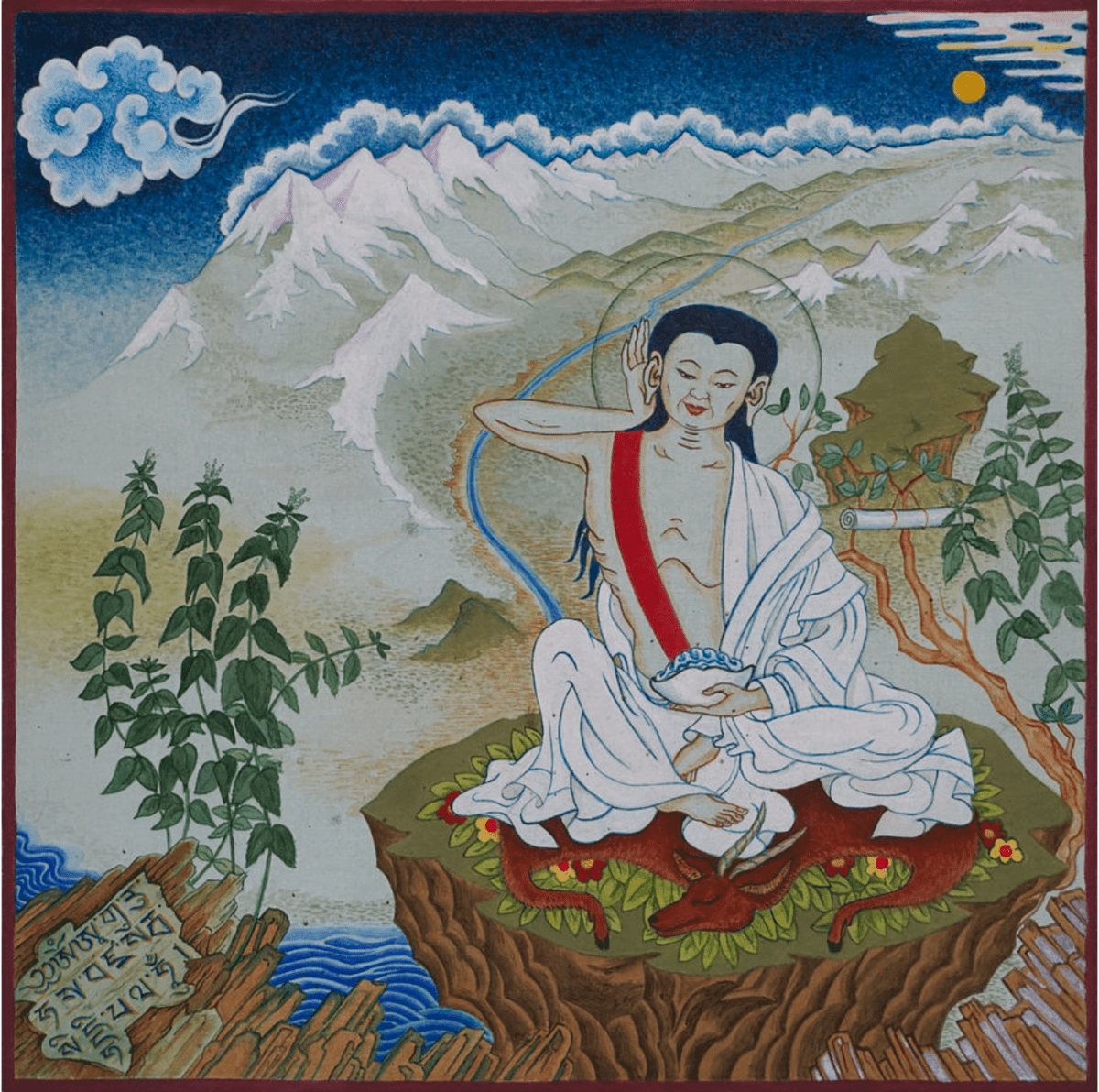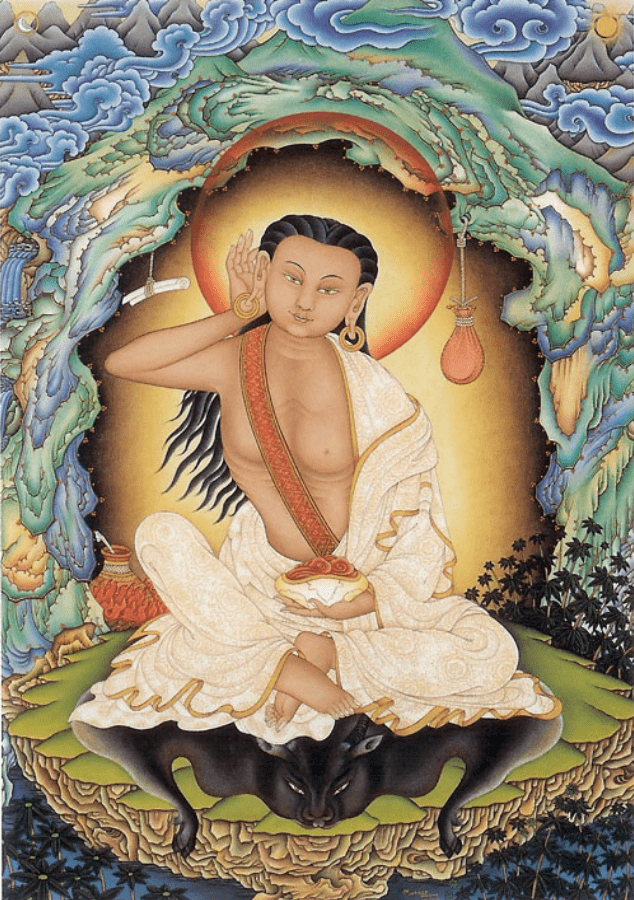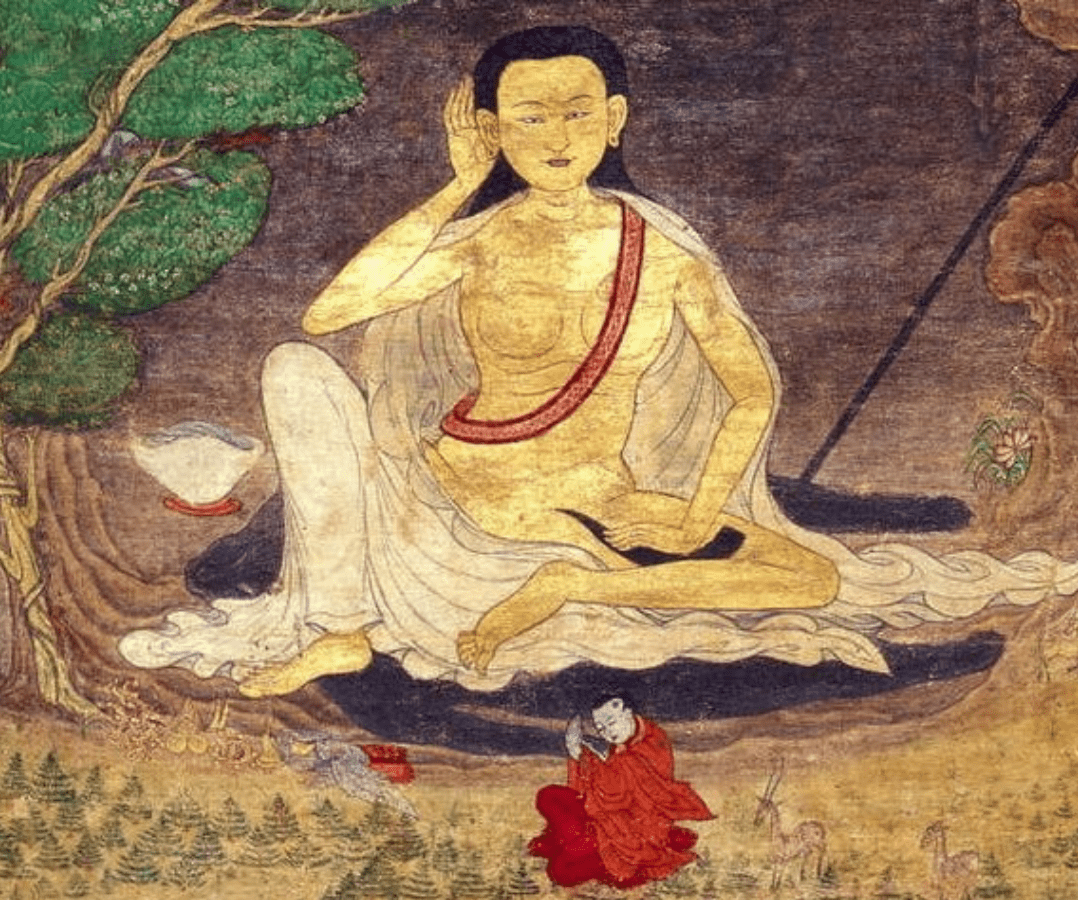 How do we navigate the Bardo at the moment of death? Let’s listen to the great Saint of Tibetan Buddhism. Milarepa’s final song describes our choices in that critical moment. His life of hardship, family betrayal, black magic, backbreaking work, near suicide, isolation, disillusionment, and finally freedom can be an inspiration to all of us who wish to ascend beyond the veil of illusion.
How do we navigate the Bardo at the moment of death? Let’s listen to the great Saint of Tibetan Buddhism. Milarepa’s final song describes our choices in that critical moment. His life of hardship, family betrayal, black magic, backbreaking work, near suicide, isolation, disillusionment, and finally freedom can be an inspiration to all of us who wish to ascend beyond the veil of illusion.
In his youth Milarepa’s distraught mother begged him to avenge the cruel enslavement of his family. So he studied the dark arts and became proficient in black magic. He performed evil rituals and incantations that caused untold harm. An entire valley was filled with a writhing mass of snakes, lizards, spiders, and frogs. The horses went wild with panic, reared up, and kicked down the stable walls, causing a large building to collapse, killing all the guests at a wedding party. His next evil spells caused enormous menacing black clouds to gather over the fields, and giant hailstones completely destroyed homes and crops, the very livelihood of the community.
In spite of his success at black magic, Milarepa felt no pleasure bringing ruin to others. Eventually he found a true teacher Marpa, “The Translator”, of the Tibetan Kagyu Lineage. Marpa was a tough, seasoned yogi who possessed the sheer audacity and courage to challenge Milarepa to fulfill his destiny to carry on the lineage and eventually win freedom.
What does Milarepa say in his last song?
The final song of Milarepa is useful advice to all of us. In his life as a renegade Tibetan singer, he lived in a cave and ate so many nettles that his skin was said to turn GREEN! In this last song, he tells how to cross over from the physical world upon death. He describes how to pass through the confusing “Bardo” or “Purgatory” into your next life.
Read the song below for yourself. Milarepa says we MUST have a meditation practice to prepare for this passage. A successful death practice will build habits that guide us to a BETTER next life. Milarepa lived from 1052-1135 CE in Tibet, where he was greatly admired for his impromptu songs, some of which are still popular.
Milarepa was a lay yoga practitioner who reached enlightenment in a single lifetime, without any formal training, monastic vows, or Buddhist title. Traditionally painted singing with one hand cocked to his ear, he always wears white cotton even in frigid winter, and his skin is a slight greenish hue from an austere diet of nettle soup.
Milarepa was born into a prosperous family in Western Tibet in the village Kya Ngatse. As a child, he was known for his beautiful songs, and people called him “Mila Thopja” meaning “a joy to hear”. After his father died, it is said that his aunt and uncle robbed his family of all their property and wealth. His mother sent him to become a sorcerer to revenge their total loss. Milarepa soon became extremely skilled at black magic, wreaking vengeance for his mother and for the treatment of his family. He became expert in evil weather wizardry, creating magic hailstorms that destroyed provinces, homes, farms, families, and crops. He used magical spells to murder many people.
As a carrier of evil, Milarepa felt deep dissonance and remorse. He sought the help of Marpa, the famous Tibetan Buddhist teacher. Marpa saw great potential in Milarepa, but he knew the young man would have to work through his evil Karma and personal uncertainty in order to truly become a student. To prepare him for the life of spirit, Marpa gave Milarepa his legendary task of building stone towers, taking them down, and rebuilding them again. So many times! Milarepa gave up disgusted several times, but somehow he always came back and finished the job. This unique series of assignments was necessary for Milarepa to purify the negativity of his past actions, so that his spiritual progress could move forward without obstacles.
When they first met. Marpa challenged Milarepa almost to the point of suicide before he agreed to accept him as a student. Finally he accepted Milarepa. And Milarepa began his journey to clear his karma, to become the famous yogi, singer, and poet as we remember him today. He began his simple, lonely lifestyle living in caves, eating mostly nettles. He wore little clothing, even in the winter, and became known as “the cotton-clad one.” Though he did not seek students, his fame spread, and he was sought out by many. It is said that Milarepa “engaged with whoever approached him,” He often taught by sharing spontaneous songs and poetry.

Marpa was one of the founders of the Kagyu tradition stemming from the tantric teachings of the Indian Mahāsiddha, Nāropa. Historians say that Marpa ordered Milarepa to construct a multi-story building with stones from a particular quarry. When complete Marpa told Milarepa to dismantle it and return each stone to its place of origin, in order to test to see that Milarepa was serious about the daunting task before him, and worthy of high teachings. This was repeated several times, and was later revealed by his teacher Marpa as a painful but effective way to to exhaust the negative karma accumulated from Milarepa’s evil actions as a youth. This stringent purification made it possible for him to reach Buddhahood in one lifetime. The last ten-story tower that he built is said to be still standing to this day.
Milarepa lived much of his life in remote caves in Tibet, with little to eat, often subsisting on nettles. Sometimes surprise encounters with visitors in the mountains became potent teaching experiences for them, turning ordinary events into serendipitous songs, as Milarepa jokingly taught the true dharma. “Living the Dharma” means utilizing each event in one’s life as a profound realization. For example, when his only cooking pot broke in winter leaving just dry nettles in the shape of the pot, he faced starvation with no way to travel or cook. This was a profound opportunity to understand the concepts of “detachment” and “impermanence”.
After twelve years of diligent study with Marpa, Milarepa reached complete enlightenment. His life and uniquely personal teachings are kept alive by his ardent followers throughout Tibet and Bhutan. Milarepa did not just sing songs about the Dharma path. He fully embodied the Dharma, the challenges of living in a physical body and achieving an end to Samsara, the pattern of repeated birth and rebirth. Because of that, he was able to teach and sing freshly, spontaneously, and with great humor, using skillful word plays and multi-level meanings.
This chant is said to be Milarepa’s last words. At the end of his life, legend holds that Milarepa passed away quietly in the presence of his loving students. But then – he got up from his deathbed to sing this final message in perfect verse. Then he lay down once again and closed his eyes forever!
These sacred words in Tibetan are full of metaphors and hidden meanings hard to translate.
Lama D has given us a translation of Milarepa’s last song:
- Purnyitajaverechonpa, Kachemdanga-dode-nye
My dearest son, Rechonpa, You must listen to the song of my final words. - Khamsumaokuhwenjansonye, Julekephonpodeponche
The three worlds (Heaven, Earth, Hell) are like a big ocean. The body is magical, but that is an optical illusion. Really this world it is full of stress. - Doghukyechempaadodonye, Jekenenjawatode-me
If you are looking for a luxury way of living, with possessions and comforts, it will never end, you keep looking for more and better. - Jektenkejawa-toncherechonpa, Jumalechetonkhena
For that reason, Rechuba, you have to avoid it, because it is impermanent. The beauty you see around you is all a magical optical illusion. - Zhansenmuhme-depoche, Leshanchagyenchessun-taja-nye
The invisible mind will become full of stress because of your desire if you have any attachment to your body, which is made of blood, nerves, bones, flesh. - Chönye-delatondume. Senyendasancherenchonpa
You will never know what is the value of enlightenment. You MUST study and purify your mind and then you will get the real value of Nature. - Pembreynyekye-soensanam, Ranjemonyeshe-depo-che
The moment we separate the mind and soul from the body, this is a huge stress for you, if you have not practiced pure positive mind. - Lhonburenje-chenkhatemkheme, Kemenkhenjenalapondeme
Uncertain obstacles can be a huge domination of our wisdom. Then we will not get the knowledge of enlightenment. - Kemensensasoishe-rechonpa, Tsedechenyikhe-sosanna,
The place of enlightenment is so calm, Rechuba, you have to catch it. While we exchange this life for another life, there is another life between this and that. That is the Purgatory or cleansing life. Again, you will see huge stress in that lifetime, because you will be looking for another body. - Ba dhe- namshe de po che, Lue me dur dan don do me.
During that life, we have no body. The invisible mind wants to get a good body for the next life. Because of that again you will have huge stress. - Dhye lo duh la- pon de me, Ne lo de la pon che- nye le chon pa
Human life is the best, because you can build virtue through dharma, and you can know the value of getting enlightenment. So, you constantly accumulate that value. - Rigdu tuelwe dong kher na, Lengyem de dye tsem po che
Heaven universe and human world and Hell and the animal world, and the world of the hungry ghosts all have a huge negative body. When there is a huge negative body, automatically the consequence is huge stress. - .Chantangye je so- dang da nay, Gnyampa nyi la- tog due- me
If we have high attachment to anything, if we are partial to something, then we will lose our compassion. If we do not practice compassion, we will never achieve the value of enlightenment. - Cha dang a pang shing rechu pa! Mi ngoen nam khi iyng shig na
Rechuba, you should not be partial! When we get into an invisible place (purgatory), you can hear some sounds and some lamas mantra. But, if you have no practice, and are not used to the mantra, then you cannot understand what they are saying – it is like lies. - Dzong pe sanje- zhen zuen khen, Even the Buddha’s mantra is also like soft lies.
- Dang den gye lo che i sung su nye. Nyepe e de la to duh me,
Even if all the Buddhas come in front of you to teach you the authentic nature-pure way, still we cannot get it, because we have no habit for what is absolute Dharma. - Tanye ponh si re chon pa.
Rechuba, you must avoid activities for this Samsara life. It has no value. - Lama nyedamaa- kha do sun, Chiktu de- la suelwa- thop
You must call in the Lama, the Yidam (your trusted God), and your Dakini.
Then you can get the blessings from them, with highest respect to them. - Tawa- gho pa che pa sun, Chi ton tuh la nyam su lo
Your highest goal is enlightenment. You have to meditate about it intensely. - Tse dyen da chyemaa- bardo sum, Chento de la deso- choe
This life, next life, and life of purgatory in-between, before you die, you must ask yourself to understand all 3 lives. (Purgatory is scary because that is when your next realm will be determined: It will be either Heaven, Hell, Human, Animal, or Ghost realm) - Dyen damnga a kuen gye tamaeing, Kha chem kuen ghi ju maeing
This is my final high sacred advice, my final words - Dhun dele me go- re chu pa! Denyam so lang shi- fa yin bu
No more now, Rechupa. Don’t forget this, my son. - Dhun dele me go- re chu pa! Denyam so lang shi- fa yin bu
No more now, Rechupa. Don’t forget this, my son.
༼ རས་ཆུང་པ་ལ་ ཐ་མའི་གདམས་ངག ༽
- ༄། བུ་སྙིང་དང་ འདྲ་བའི་རས་ཆུང་པ།།
- ཁ་ཆེམས་གདམས་ངག་གླུ་འདི་ཉོན།།
- ཁམས་གསུམ་འཁོར་བའི་རྒྱ་མཚོ་ནང་།།
- སྒྱུ་ལུས་ཀྱི་ཕུང་སྡིག་པོ་ཆེ།།
- ལྟོ་གོས་ཀྱི་ཞེན་པ་སྒྲུབ་སྒྲུབ་ནས།།
- འཇིག་རྟེན་བྱ་བ་མཐོང་དུས་མེད།།
- འཇིག་རྟེན་བྱ་བ་མཐོང་ཤིག་རས་ཆུང་པ།།
- སྒྱུ་མ་ལུས་ཀྱི་གྲོང་ཁྱེར་ནང་།།
- རང་སེམས་དངོས་མེད་སྡིག་པོ་ཆེ།།
- ལུས་ཤ་ཁྲག་གི་རྗེས་སུ་འབྲང་འབྲང་ནས།།
- ཆོས་ཉིད་དོན་ལ་རྟོགས་དུས་མེད།།
- སེམས་ཉིད་བརྡར་ཤ་ཆོད་ཅིག་རས་ཆུང་པ།།
- བེམ་རིག་གཉིས་ཀྱི་སོར་མཚམས་ན།།
- རང་བྱུང་ཡེ་ཤེ་སྡིག་པོ་ཆེ།།
- གློ་བུར་གྱི་རྐྱེན་ཁ་འགྲིམས་འགྲིམས་མས།།
- སྐྱེ་མེད་ཀྱི་དོན་ལ་རྟོགས་དུས་མེད།།
- སྐྱེ་མེད་བཙན་ས་བཟུང་ཤིག་རས་ཆུང་པ།།
- ཚེ་འདི་ཕྱི་གཉིས་ཀྱི་སོར་མཚམས་ན།།
- བར་དོའི་རྣམ་ཤེས་སྡིག་པོ་ཆེ།།
- ལུས་མེད་ལུས་དང་འགྲོགས་འགྲོག་ནས།།
- གནས་ལུགས་དོན་ལ་གཏོགས་དུས་མེད།།
- གནས་ལུགས་གཏན་ལ་ཕོབ་ཅིག་རས་ཆུང་པ།།
- རིག་དྲུག་འཁྲུལ་བའི་གྲོང་ཁྱེར་ནང་།།
- ལས་ངན་སྡིག་སྒྲིབ་ཚན་པོ་ཆེ།།
- ཆགས་སྡང་རྗེས་སུ་འབྲངས་འབྲངས་ནས།།
- མཉམ་པ་ཉིད་ལ་རྟོགས་དུས་མེད།།
- ཆགས་སྡང་སྤོངས་ཤིག་རས་ཆུང་པ།།
- མི་མངོན་ནམ་མཁའི་དབྱིང་ཤིག་ན།།
- རྫོགས་པའི་སངས་རྒྱས་ཞལ་རྫུན་མཁན།།
- དྲང་དོན་གྱི་བསླུ་བྲིད་ གསུངས་གསུངས་ནས།།
- ངེས་པའི་དོན་ལ་རྟོགས་དུས།།
- ཐ་སྙད་སྤོངས་ཤིག་རས་ཆུང་པ།།
- བླ་མཡིད་དམ་མཁའ་འགྲོ་གསུམ།།
- གཅིག་ཏུ་དྲིལ་ལ་གསོལ་བ་ཐོབ།།
- ལྟ་བ་སྒོམ་པ་སྤྱོད་གསུམ།།
- གཅིག་ཏུ་དྲིལ་ལ་ཉམས་སུ་ལངས།།
- ཚེ་འདི་དང་ ཕྱི་མ་བར་དོ་གསུམ།།
- གཅིག་ཏུ་དྲིལ་ལ་འདྲིས་སུ་ཆུག།
- དེ་གདམས་ངག་ཀུན་གྱི་ཐ་མ་ཡིན།།
- ཁ་ཆེམས་ཀུན་གྱི་མཇུག་མ་ཡིན།།
- དོན་དེ་ལས་མེད་དོ་རས་ཆུང་པ།།
- དེ་ཉམས་སུ་ལོངས་ཤིག་ཕའི་བུ།།

Milarepa is said to have spent the later years of his life in the Milarepa Cave, 11 km north of the town of Nyalam, near the Matsang River in Tibet. Milarepa’s Cave overlooks the entrance to the hidden valley of Lapchi Gang. Pilgrim’s offerings of decorated stones along the path with sweet-smelling herbs and wild flowers growing all around make it a site of great peace and beauty.

Milarepa is usually depicted with an emaciated, thin body due to great deprivation and hardship. He often has a hand to one ear as if filtering his voice as a singer, with lips parted as if singing one of his famous songs of realization.

“The affairs of the world will go on forever. Do not delay the practice of meditation.”
Jetsun Milarepa, 10th century CE Tibet
Further Reading:
https://www.lightforcenetwork.com/shabda-preceptor/milarepa-black-magician-mastership


